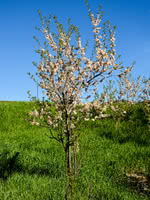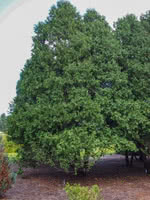Mon-Fri 9am - 5pm Mountain time
Eastern White Cedar (Arborvitae) vs Canada Plum & American Plum
Prunus nigra and americana
Thuja occidentalis
Canada and American Plum are almost identical in appearance and growth needs. These plants are short and stout fruit trees native to North America.
This hardy ornamental is excellent for both city dwellings as well as rural areas. During the spring, the white and pink blossoms are long lasting. The tasty fruit is suitable for fresh eating, baking, and preserves. These trees are not widely distributed and pure seed can be hard to come by.
Both are commonly used as rootstock and are considered universal pollinizers for other plum varieties.
Eastern White Cedar is a slender growing conifer often used as a decorative tree or a hedge. This tree is an effective privacy screen even in winter and a great long term solution to urban crowding or a drab yard.

